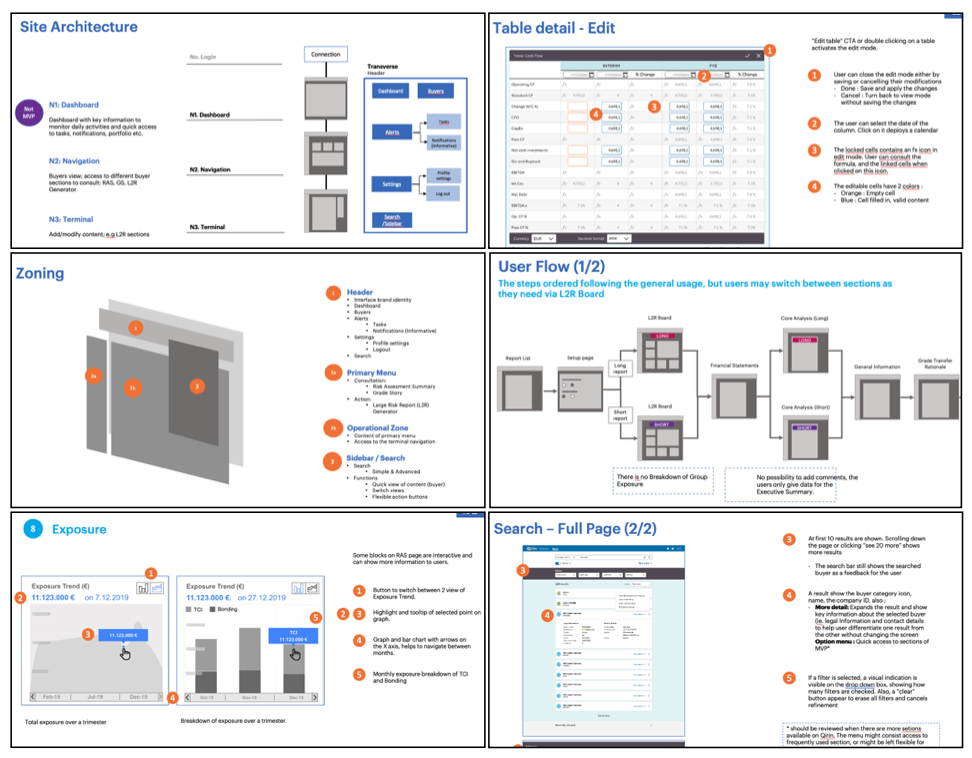Transforming corporate risk assessment through integrated workflows and data visualisations
Contract : 2 years (2020-2022)
Role : Lead UX Designer
Provided expertises : User interviews・3 days Design Sprint・User flows・Dashboard Design ・Wireframing and prototyping・User testing ・Design System
Tools : Sketch・Miro・Microsoft Excel
Industry : Trade credit insurance & credit management
Background
With the ambition of strengthening the reliability and efficiency of its risk assessment workflows, a leading credit insurer sought to overhaul one of its core in-house tools for corporate risk evaluation. The existing tool was outdated, fragmented, and no longer aligned with the company’s processes. Critical activities — such as producing extremely detailed credit and risk analysis reports requiring multiple validation points — were still managed through PDFs and across dispersed platforms, creating inefficiencies and risks.
The project focused on three main objectives:
Enable seamless navigation by redesigning the interface architecture.
Provide a consolidated company overview to support efficient credit assessment and score follow-up, while streamlining the advanced risk report process.
Enhance decision-making through consistent and meaningful use of color codes across the interface.
Challenges
The redesign had to address multiple layers of complexity:
Fragmented workflows : Analysts gathered data manually from different databases and platforms, often relying on country-specific Excel tools with macros before copy-pasting into reports.
Inefficiencies in client interactions : Finding key information during meetings was slow and unreliable, undermining trust and credibility.
Diverse user needs : Credit analysts and risk underwriters required different levels of detail, adding to the complexity.
Design paradox : The tool had to simplify workflows without oversimplifying, preserving the rigor essential for corporate risk assessment.
Outcome
The solutions we delivered before my departure already created visible improvements in analysts’ workflows:
From manual reports to integrated workflows : Previously, credit analysts spent significant time compiling PDFs from multiple platforms. With the integrated reporting feature, they could now generate reports directly in the tool, saving time and reducing errors.
From one-size-fits-all to tailored views : Static PDFs offered no flexibility. With the redesigned tool, executors and validators had dedicated views — for example, validators could access the executive summary first — streamlining validation and decision-making.
From raw data to actionable insights : Instead of navigating dispersed databases, analysts began exploring risk dashboards with interactive charts, turning complex datasets into clear, visual insights.
MY CONTRIBUTION
As Lead UX Designer, I worked alongside a Junior UX Designer and a UI Designer.
My contributions spanned from user research orchestration to interface design and cross-functional collaboration within an agile development environment.
I prepared and facilitated the global Design Sprint that aligned 15 stakeholders and designed comprehensive information architectures, dashboards, tables and data visualizations, transforming complex datasets into actionable insights for analysts. I created the Design Principles deck that served as the visual specification bridge between design and development teams.
Throughout the project, I maintained close collaboration with the agile product team, attending daily standups, participating in technical decisions, and facilitating co-design workshops with business stakeholders and the Product Owner. This embedded approach ensured seamless integration of user-centered design within technical and business constraints.
Design principles
To bridge design and development, we created a comprehensive Design Principles deck featuring visual specifications, user flows, and implementation guidelines
Project key moments
User interviews and observations・3 days Design Sprint・Experience mapping・Co-design workshops・Personae・UX Wireframes・User testing・Design Principles handout (design specs)
This content is confidential and shared for recruitment purposes only. Please do not share without permission. I’d be happy to share more details upon request while respecting confidentiality—just reach out!


